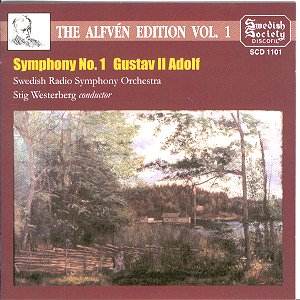Hugo ALFVÉN (1872-1960)
Symphony No. 1 (1897)
Gustav II Adolf suite (1932)
 Swedish Radio SO/Stig
Westerberg
Swedish Radio SO/Stig
Westerberg
rec 1972 (sym), 1967 (Gustav)
The Alfvén Edition Vol. 1.
 SWEDISH SOCIETY DISCOFIL SCD1101 [75.25]
SWEDISH SOCIETY DISCOFIL SCD1101 [75.25]
www.prophone records.se

Swedish Society are breathing new life into their catalogue. The tapes (usually
of high and sturdy quality) are being recoupled with long running times.
The Alfvén orchestral music is a staple of Stefan Nävermyr's
label. The First Symphony, with its dignity, resolute tone, humour and colour,
carried resemblances to that of Berwald (listen to the end of the first
movement), Elgar and Brahms without quite the total elation and compelling
invention of the latter two. The composer is good at charm and his Tchaikovskian
wind writing dances and smiles guilelessly out at you in the third and fourth
movements. Uncharacteristically the engineer seems to have held back on the
levels for climaxes leaving some of the punches pulled. The Gustav music
from 1932 is free from technical blemish (the quiet clicks in the
Bourrée are presumably the sound of the woodwind levers?) and
lacks nothing in imagination. Emperor Ferdinand's Chapel and The
Vision are regal, hymn-like (Dawn on the Moskva), and in it you
catch echoes of Mascagni, Strauss (Rosenkavalier) Sibelius
(Finlandia) and Tchaikovsky. You do not expect Intermezzos to be fugal
but this one is and an antidote it is too to all those machine-like fugues.
Similar qualities hiccup their way through the Bourrée but
in Mozartian accents. The dashing activity of the Intermezzo is like
the visceral sections of Elgar's Introduction and Allegro crossed
with a pinch or two of Mussorgsky and Tchaikovsky. The Elegy is heartfelt
but lacks memorability a quality fully in play in the 11 minute
Breitenfeld finale. This returns to the rising hymnal devotion and
passion of the Vision and Chapel. It also adds a stormy Lisztian
cavalry assault for good measure rolling in filmic waves of brass fanfares
and Aida-reminiscent trumpetry.
Generously served up, this disc is well worth adding to your collection.
There is no similarly coupled competition. I can hardly wait for the Fourth
Symphony. Can we hope that it will jump the queue?
Rob Barnett


